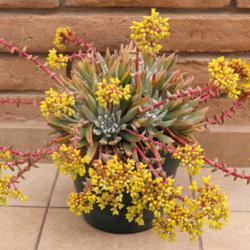General Plant Information (Edit)
| Plant Habit: |
Cactus/Succulent
|
| Life cycle: |
Perennial
|
| Sun Requirements: |
Full Sun to Partial Shade
|
| Minimum cold hardiness: |
Zone 9b -3.9 °C (25 °F) to -1.1 °C (30 °F)
|
| Leaves: |
Glaucous
Evergreen
|
| Fruit: |
Dehiscent
|
| Flower Color: |
Yellow
|
| Bloom Size: |
Under 1"
|
| Flower Time: |
Spring
Late spring or early summer
|
| Suitable Locations: |
Beach Front
Xeriscapic
|
| Uses: |
Will Naturalize
|
| Wildlife Attractant: |
Bees
Hummingbirds
|
| Resistances: |
Drought tolerant
Salt tolerant
|
| Pollinators: |
Birds
Bees
|
| Containers: |
Suitable in 1 gallon
Suitable in 3 gallon or larger
Needs excellent drainage in pots
|
| Miscellaneous: |
Goes Dormant
|
- Sand Lettuce
- Bluff Lettuce
- Coastal Dudleya
- Sea Lettuce
Posted by
Baja_Costero (Baja California - Zone 11b) on May 15, 2019 5:01 PM concerning plant:
Coastal Dudleya from central and southern California, including the northern Channel Islands. Leaves may be pale green or usually a powder-dusted pale blue. Rosettes may branch extensively. Flowers are cup-shaped and bright yellow, rarely red or orange, appearing in late spring and early summer (later than coastal Dudleya species found to its south), and attracting hummingbirds.
This plant exists in a complex with D. farinosa and a few other species. It may be distinguished from the very similar D. farinosa based on its flowers, which are a brighter lemon yellow, and its origin, which is generally to the south. The two species may form natural hybrids.
Highly susceptible to mealy bugs in cultivation (examine the center of rosettes during late spring and summer; look for ant traffic).
This plant was released as ISI 273 (green and white forms) in 1958, and ISI 2002-18 (white form) in 2002.
« Add a new plant to the database
» Search the Dudleyas Database: by characteristics or by cultivar name
« See the general plant entry for Dudleyas (Dudleya)
« The Dudleyas Database Front Page
« The Plants Database Front Page











